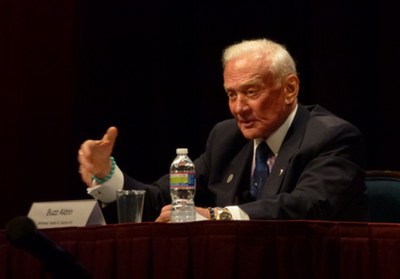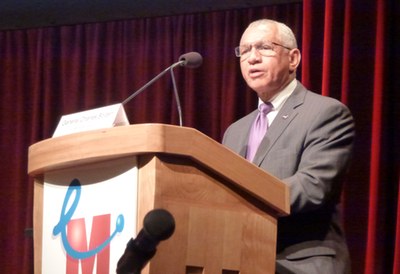Asteroids: on the way to Mars, or just in the way?by Jeff Foust
|
| “A human mission to Mars is today the ultimate destination in our solar system for humanity, and a priority for NASA,” said Bolden. “Our entire exploration program is aligned to support this goal.” |
Those characteristics were on display last week at the Humans to Mars, or H2M, Summit last week in Washington, DC. The three-day conference was designed to, in the words of Explore Mars, the organization putting on the event, “address the major technical, scientific, and policy-related challenges that need to be overcome to send humans to Mars by 2030.” By the standards of many Mars advocates, that 2030 deadline sounds relatively sedate; however, it is no less challenging given the magnitude of those challenges discussed at the conference.
The conference also took place just a month after NASA unveiled its fiscal year 2014 budget proposal, whose centerpiece is a new asteroid initiative that has the goal of redirecting an asteroid into lunar orbit to be visited by astronauts, perhaps in 2021 (see “To catch a planetoid”, The Space Review, April 22, 2013). NASA has pitched this effort as a necessary stepping-stone towards human missions to Mars, but some Mars advocates see the program as little more than an unwelcome distraction to their ultimate aim.
The case for asteroids and Mars
NASA had a major presence at the conference literally from beginning to end, starting with a keynote address by NASA administrator Charles Bolden on the morning of May 6. He argued that all of NASA’s human spaceflight efforts, from the development of commercial crew transportation systems to the asteroid retrieval mission, were key steps towards the “ultimate” goal of landing humans on Mars.
“Interest in sending humans to Mars I think has never been higher,” said Bolden. “A human mission to Mars is today the ultimate destination in our solar system for humanity, and a priority for NASA. Our entire exploration program is aligned to support this goal.”
That includes, he said later in his speech, the asteroid retrieval mission. “It takes advantage of the hardware on our deep space technologies that will provide valuable experience in mission planning and operations that are needed for future crewed deep space missions, including our planned visit to Mars,” he said.
In a panel following Bolden, three NASA associate administrators went into more detail about the potential benefits that an asteroid capture mission would have for future human Mars missions. Bill Gerstenmaier, the NASA associate administrator for human exploration and operations, noted in particular the operational experience a human mission to a captured asteroid would provide.
“We get a chance to experience a different risk environment,” he said, without the ability to quickly return to Earth if something goes wrong. “I think that’s what we’re going to have to do if we go to Mars. We have to break the mentality that we can get back to the Earth, because once you begin a journey to Mars, everything had better be right, everything better be in place.”
“We’ve been very clear that this is not a science-driven mission,” said John Grunsfeld, NASA associate administrator for science, arguing that the asteroid retrieval concept is instead focused primarily on technology development.
| “Bringing an asteroid back to Earth? What does that have to do with exploration?” asked Aldrin. “Not very much, in my way of thinking.” |
Among those technologies that would be demonstrated on the asteroid mission is solar electric propulsion; the 2014 budget request includes $40 million to start work on such systems that would be used by the robotic spacecraft that captures and redirects the asteroid into lunar orbit. That same propulsion technology could also be used for Mars missions, particularly for cargo spacecraft. “One of the highest priority items we need, and one we have been working on for years, is high-power solar electric propulsion,” said Michael Gazarik, NASA associate administrator for space technology.
“If you look at what we’re doing today, I think you can make a good argument—at least I’m convinced—that doing this operation, this mission, pushes us forward in the direction we need to go,” he added.
 Apollo 11 astronaut Buzz Aldrin argued that NASA’s asteroid retrieval plans had more relevance for planetary defense than for human exploration. (credit: J. Foust) |
Captured versus “free range” asteroids
Others at the H2M Summit, though, were less convinced about the utility of NASA’s asteroid mission as a stepping-stone to human missions to Mars. While not opposed to doing deep space missions, including to near Earth objects, some saw the idea of moving an asteroid into cislunar space as one that had little relevance to Mars exploration.
“Bringing an asteroid back to Earth? What does that have to do with exploration?” asked Apollo 11 astronaut Buzz Aldrin in a speech at the conference May 8. “Not very much, in my way of thinking.”
Aldrin said he was not opposed to human missions to asteroids, and included them into what he calls his “Unified Space Vision”: a schedule of missions that result in sending humans to Mars by the early 2030s, with precursor missions to the Earth-Moon L-1 and L-2 points, comets and near Earth asteroids, and the Martian moon of Phobos.
Aldrin said he interpreted the original asteroid mission goal—a visit to a near Earth asteroid by 2025, as laid out by President Obama in 2010—as “a good stopping point” in an extension outward of NASA’s human spaceflight program. “Now it’s turned into a whole planetary defense exercise at the cost of extending our exploration capabilities,” he concluded.
Others argued that missions to near Earth asteroids would provide useful spaceflight experience building up to Mars missions that a mission to an asteroid in lunar orbit, just a few days away, would not. Josh Hopkins of Lockheed Martin drew parallels to the experience built up by European sailors in the 15th century, gradually expanding their reach down the African coast before sailing to India. Going to asteroids beyond the Moon, he said, would provide similar experience.
“When I’m talking about going to asteroids, I’m not talking necessarily about visiting one that’s been brought back to lunar orbit,” he said. “I’m talking about visiting an asteroid in its natural habitat: a ‘free range’ asteroid, if you will.”
And some Mars advocates thought that sending humans to any asteroid, including a captured one, simply wouldn’t be as interesting to the public as human missions to Mars. Artemis Westerberg, the president of Explore Mars, noted that a poll conducted for the organization earlier this year found that only 14 percent of Americans considered human missions to near Earth asteroids the “most valuable” mission NASA could perform; a human mission to Mars ranked much higher. “Why stand on a rock,” she said, “when you can walk on a world?”
Other challenges
Even if NASA carries out a human asteroid mission, there are other technical challenges that the space agency will need to be address that an asteroid mission will need to address. One of the biggest is also one of the most basic: landing on the surface of the Red Planet.
| “Why stand on a rock,” Westerberg said of the asteroid mission, “when you can walk on a world?” |
“We’re all very attuned to the success of the Curiosity mission,” said Bobby Braun, a professor of space technology at Georgia Tech and former NASA chief technologist. However, Curiosity weighed about one metric ton, while concepts for human Mars landers weigh up to 40 metric tons. “While that was an amazing accomplishment, it’s really a baby step that we need to take on the way to one day walking on Mars.”
The problem, Braun and others noted during a session at the H2M Summit on May 7, is that the technologies used to land Curiosity and smaller spacecraft on Mars don’t scale up to the much larger, heavier landers needed for human missions. “When we go to think about very big objects—the size of houses—parachutes don’t come along for the ride,” said Adam Steltzner, the lead engineer for the entry, descent, and landing (EDL) system for Curiosity. “A parachute the size of the Rose Bowl, which is what it would need to be for human exploration, is something we already know from our experience on Earth is not practically manageable.”
One solution is to eschew parachutes in favor of greater use of rocket engines, including at higher speeds, something known as supersonic retropropulsion. But while rocket engines have been used for Mars landings in the past, it’s been in the terminal phases of landing, at much lower speeds. “If we’re going to initiate retropropulsion at Mach 2 or Mach 3 on Mars, there are some really significant issues that we have to confront,” said Charles Campbell of NASA’s Johnson Space Center. That includes the performance of the rocket motor and the ability to control the vehicle, particularly if, as expected, precise landing is required.
There are also the various physical and mental health issues involved with keeping humans alive, and functioning at a high level, over a mission that could last years, depending on the particular architecture selected. Among the biggest medical issues is radiation exposure, and how to handle those risks to the crews going to and from, and living on, Mars.
“We will almost certainly exceed some of those exposure standards when we start doing longer-duration exploration-class missions, particularly to Mars,” said Richard Williams, NASA chief health and medical officer, referring to national standards for lifetime exposure to radiation. “We need to start figuring out how we’re going to deal with this in an ethically acceptable fashion.” That could involve changing those exposure limits or waiving them entirely, or “we create some formula where, administratively, risk is accepted by a higher authority.”
While examining those challenges, most thought that, with enough effort, the technical and physiological issues with human Mars missions could be successfully overcome. “The question shouldn’t be, ‘Can we do this?’” Braun said. “We can do this. The question really should be, ‘Will we do this?’”
In order to do this—landing humans on Mars—some warn against efforts like NASA’s asteroid mission that they see as a distraction. “We need to keep the momentum of going to Mars,” said Westerberg in her remarks at the conclusion of the conference. “Don’t go off to do other things, however great and worthy. If we want to be a multi-planet species… we need to focus: pick a vehicle, pick a target, stick with it.”
That message was, ironically, not that different from what Bolden said at the beginning of the conference. However, he sees potential distractions not from the asteroid mission his agency is advocating, but instead from those who want to return to the Moon before going to Mars. “If we starting straying from our path and going to an alternative plan, where we decide we’re going to go back to the Moon and spend a little time developing the technologies and the systems we need, we’re doomed,” he warned. “We will not get to Mars in the 2030s, if ever, to be quite honest.”
